|
McCloud River Railroad : Along the Line
Pondosa Branches |
|
|
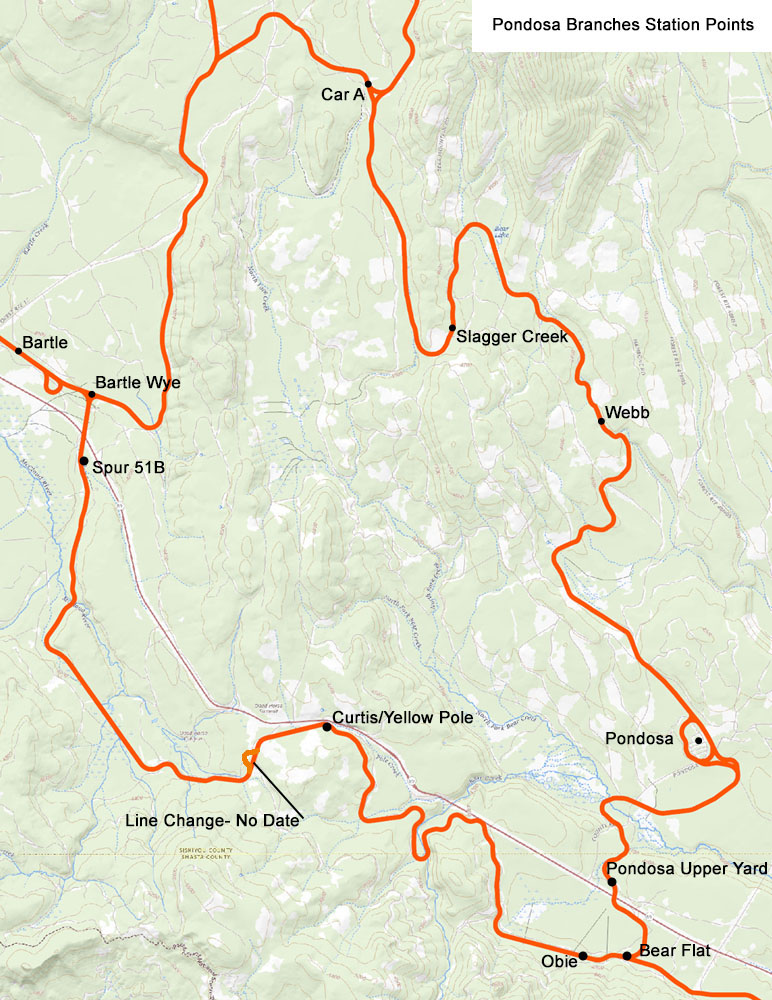
|
|
In 1924 the McCloud River Lumber Company purchased the timber on a third major tract of Red River Lumber Company land, this time the 87,000 acre Bear Creek Tract located mostly east and southeast of Bartle. The lumber company based initial operations in this sale out of Pondosa, and in 1927 they decided to move the camp ten miles south to a new spot in the middle of the tract. The lumber company built a new main line from Car A south to the new site, and the next year the McCloud River Railroad got trackage rights over the line and established common carrier service to the camp. In 1929 the railroad purchased the first 3.777 miles of the line south from Car A. The McCloud companies abandoned this line in its entirety in 1951 following completion of a new line the two companies built from Bartle into Pondosa. The railroad later incorporated this line into its Burney Extension, which cut the Pondosa Branch back to a little shy of four miles between Bear Flat at Pondosa. Original Line Car A-Milepost 43.25 (1923-1939), then 42.94 (1939-1951). Original junction with main line. Full information on this station can be found on the Young Spur to Hambone section. Slagger Creek-(also shown as Slagger Creek #3 on some maps)- Milepost 46.72. Established as end of railroad ownership on this line in 1929, with the railroad leasing lumber company trackage beyond this point. No evidence exists to suggest that this site was ever anything more than a dot on a map, though at least one later topographical map showed this station as a flag stop. Webb-Milepost 49.94. Named after Edwin J. Webb, a long time employee of the Lumber Company. Edwin retired as logging foreman of Pondosa. The site originally had a 1,100 foot long passing siding. In 1930, the railroad removed the east switch from the siding, with the switch reinstalled in 1940 and removed again in 1949. The remaining spur survived until abandonment. Pondosa-Milepost 54.33. The lumber company operated a large permanent community here from 1927 until 1964. The community boasted numerous dwellings, a dining facility, school through the eighth grade, a company store, and a recreation hall. The railroad established common carrier service to Pondosa in 1928, and it replaced Bartle as the gateway for traffic moving to and from the agricultural communities to the south and east. In 1931, Harry Horr moved his sawmill operation from Cayton Valley to a site immediately adjacent to the lumber company camp, which gave the railroad an important shipper of finished lumber. The railroad built several different spurs into different parts of the sawmill complex through the years. The lumber company railroad operations ended in 1955, but the logging crews continued to occupy the camp until it closed. The sawmill continued on under a succession of owners until 1980, when it too closed. Two large lumber company buildings remain, the old store and recreation hall, along with a few occupied and many vacant dwellings. Most of the sawmill facility remains somewhat intact, although largely abandoned. Structures - Large machine shop, enginehouse, and fuel/sand facilities, all lumber company property. - Freight depot, 24'x64'x17', 2 partitions, 2 office rooms, 1524 square feet of platforms, resting on a foundation of 74 concrete blocks, built 1928 and retired 1943. - Shelter shed, 7'6"x20'6", purchased 1928, retired 1933. - Livestock corrals, 96'x122', 3 pens, 40' loading chute, 2 water troughs, built 1923. - Three section cabins, built 1928 and retired 7/10/1929. - Agent's dwelling, built 1928 and retired 1943. - Tool house, 10'x14', built 1938. - Earthen cinder loading platform, built 1938. Water Towers - Two 12' wood water tanks equipped with 8" spouts, along with a pump house, purchased 1928 and left intact when the railroad abandoned its line into Pondosa in 1986. The local state fire station subsequently burned the tanks in a training exercise. Side Tracks - Five track yard, leased 1928 and retired 1953. - Balloon track, leased 1928, reversed 1953, and retired 1986. - Several spurs to serve parts of lumber company camp and adjacent sawmill. Pondosa Upper Yard-The McCloud River Lumber Company developed several logging railroad main lines from Pondosa out to the surrounding woods, including Spur 400 that eventually extended almost all the way to the southern end of the Bear Creek tract. This spur crossed the Mount Lassen-Mt. Shasta highway (now Highway 89) about three miles out of Pondosa, initially at grade and later on a trestle. In the late 1930s Red River sold a small part of its vast holdings around Burney to new operators who built three sawmills in that town. All three desired rail service, and to provide it the McCloud River Railroad obtained trackage rights over the lumber company's Spur 400 from Pondosa to a point just north of the highway crossing, where the railroad build Pondosa Upper Yard. Railroad facilities included three stub-end yard tracks (800', 574', 1,109') and a large earthen cinder loading platform built in 1939. Scott Lumber Company operated the largest reload operation, using a covered shed that burned circa 1946 (along with a couple boxcars) and a replacement shed collapsed by the 1951 snowfall. The railroad also handled occassional raw log and other traffic through the reload. The reload closed after the railroad completed the Burney Extension in 1955. An eight-car long spur remained through at least 1964. Revised Line In 1950 the McCloud companies decided to construct a new line into Pondosa that would open up some new logging areas and shave fifteen miles off the existing route through Car A. On 6 March 1950 the railroad applied to the Interstate Commerce Commission for authority to build 5.3 miles of new line from Bartle to Curtis and obtain trackage rights over 7.97 miles of lumber company owned lines from there to Pondosa Upper Yard. The railroad purchased the Curtis to Bear Flat in 1955 as part of the Burney extension, with the rest of the line into Pondosa acquired shortly after the lumber company closed its camp. Milepost numbers reflect the post-1955 numbering system. Bartle-Milepost 18. Official start of the Pondosa Branch/Burney line. Bartle Wye-Milepost 19. Junction of the Pondosa Branch/Burney line with the Bartle Branch. Spur 51B-Vicinity of Milepost B-22. Station consisted of a three-track yard plus a set-out track, all built circa 1951 when the lumber company started constructing Spur 51B and tributary spurs from this point west along the south side of the McCloud River. Site abandoned in 1955 when the lumber company started using Spur 50 south from Dry Creek on the Bartle Branch. Curtis (Yellow Pole)-Milepost B-25. Named after the nearby Curtis Meadows, which is named after the Curtis family, a ranching family in the Bartle area. This site marked the eastern end of McCloud River Railroad ownership from the time the line was built in 1951 until the completion of the Burney extension in 1955. The railroad maintained a three track yard here, plus a 10-car capacity spur, first for use as a place to sort log cars brought out of the woods and then to re-assemble trains brought up the mountain in sections. One of the long sidings remained basically intact until the end, but only 495' remained usable as a spur. A small tool shed also existed at the east end at least through 1981. Curtis is at the top of Dead Horse Summit. Original legends credited the origin of this name to the death loss of a large number of horses suffered by a Hudson Bay Company trapping expedition led by Alexander Roderick McLeod that spent part of the winter of 1828-1829 near here. The Siskiyou Pioneer carried a later story quoting Mr. McIntosh, Sr. to the effect that the pass really got its name after "Preacher" Mayfield "rode a fast horse into a sweat and then allowed him to drink cold water from the spring", after which the horse died. This pass provides a natural conduit for commerce, and it has been used by a major stage route, two railroads, and Highway 89. Obie-Milepost B-31. Named after Richard A. Obenland, one of the primary civil engineers employed by the lumber company to lay out logging railroad lines. Site of a three track yard originally used to interchange log loads between lumber company and railroad crews, and later used to re-assemble trains brought up the mountain in sections after the opening of the Burney line. A 600-foot long set out track from the west end of the yard also existed in the early years. The railroad removed the middle track in the early 1960s, but the other (1,717' long) remained until the end. Bear Flat-Milepost B-31.2. The revised mainline over Dead Horse Summit tied in with the lumber company's spur 400 here. The rest of the line into Pondosa operated over Spur 400, which was the logging railroad mainline extending south towards the Dana and Clark Creek areas. Following completion of the line to Burney, the trackage from Bear Flat into Pondosa officially became the Pondosa branch, with mileposts numbered with P prefixes. The last few timetables issued by the McCloud River and McCloud Railway renamed this site Pondosa and listed the remnants of the Pondosa branch as a 10,000 foot long spur. The only recorded structure was a section shed converted from a boxcar body in the middle 1990s. Pondosa Upper Yard-Milepost P-32. The new Pondosa line tied in with the end of the original Pondosa branch at this point. Pondosa-Milepost P-34, later P-3.5. Original history of this community is covered above. The new line entered Pondosa from the southeast, whereas the original line came into town from the northwest. In 1953, the railroad built a new connecting track reversing the balloon track surrounding Pondosa and abandoned the five-track yard in town. Finished lumber shipments from the Pondosa mill kept the branch active until the last operator closed around 1980. The railroad used the branch to store idled incentive per diem boxcars starting around 1983. The railroad abandoned and removed approximately half of the branch after the 1986 floods washed out the trestle that carried the branch over Bear Creek; this action also relieved the railroad of the three county road crossings that the company had to maintain on a line that did not produce any revenue. The railroad removed the bridge that carried the branch over Highway 89 around 2000, further cutting back the line. Approximately one mile of the branch remained intact until the end. |
|
|
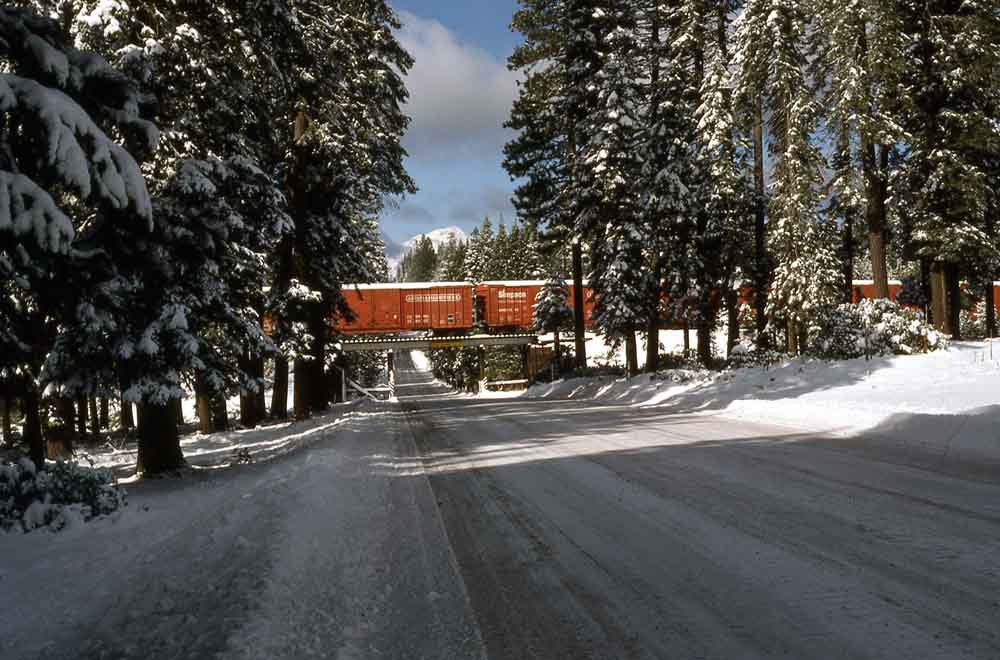 |
|
Stored Arcata & Mad River boxcars on the Pondosa branch bridge over Highway 89 in November 1985. Steven D. Moore photo. |
|
|
 |
|
Remains of a bridge over an unnamed tributary stream on the Pondosa branch just north of Pondosa Upper Yard in June 2003. Matt
Simons provided the following on this structure: "In the fall of 2000, myself, Jeff Harris, Mark Sietzinger, and Eddie Padula removed the main
support beams to be used to repair the old warehouse in McCloud. It was in perfect shape when we arrived. The
plan was to remove all of the 9"X17"X30' timbers, but other maintenance tasks prevented us from going back. It
was cool to help take the thing apart. All of the construction was so solid we had one heck of a time getting
those beams apart! We ended up shattering the pivot gear on the old white boom truck, so we were only able to
get five timbers back to McCloud."
|
|
|
|
Matt Simons sent several other detail shots of this bridge.
|
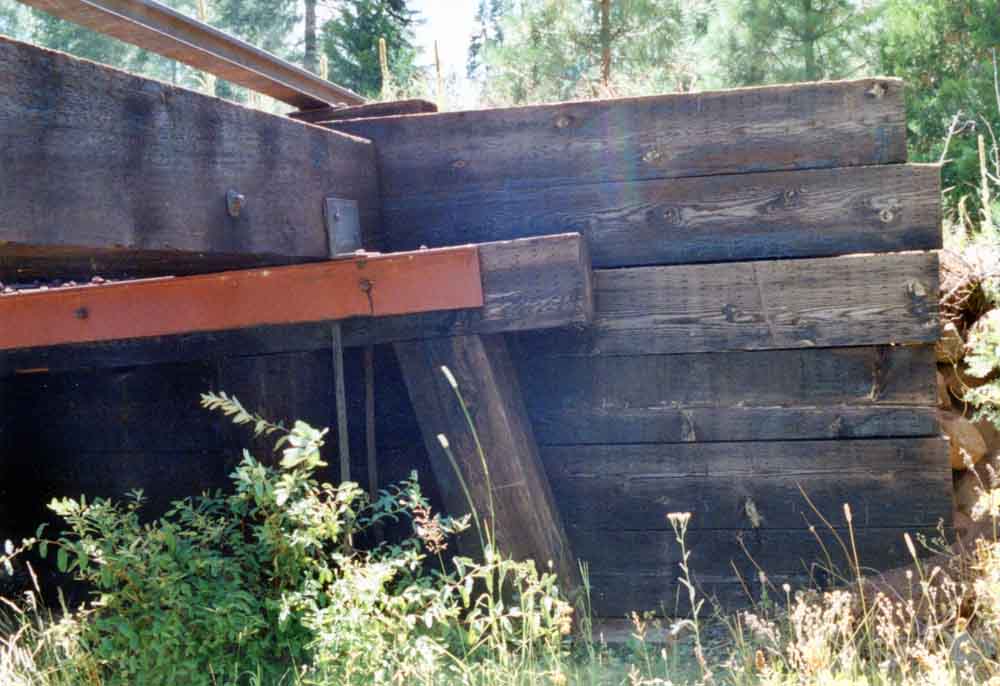 |
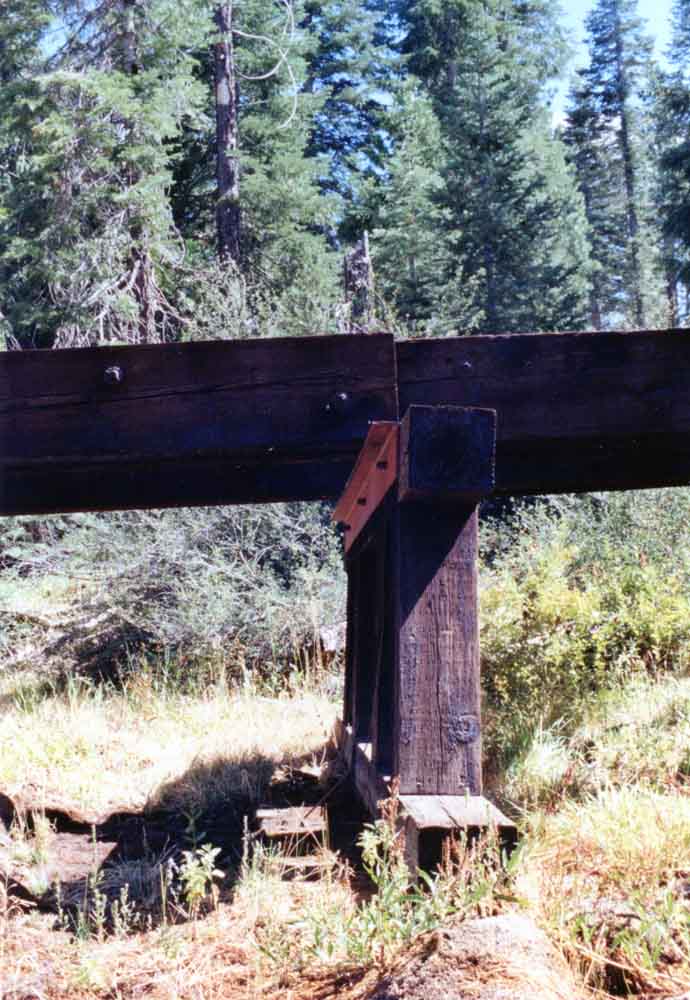 |
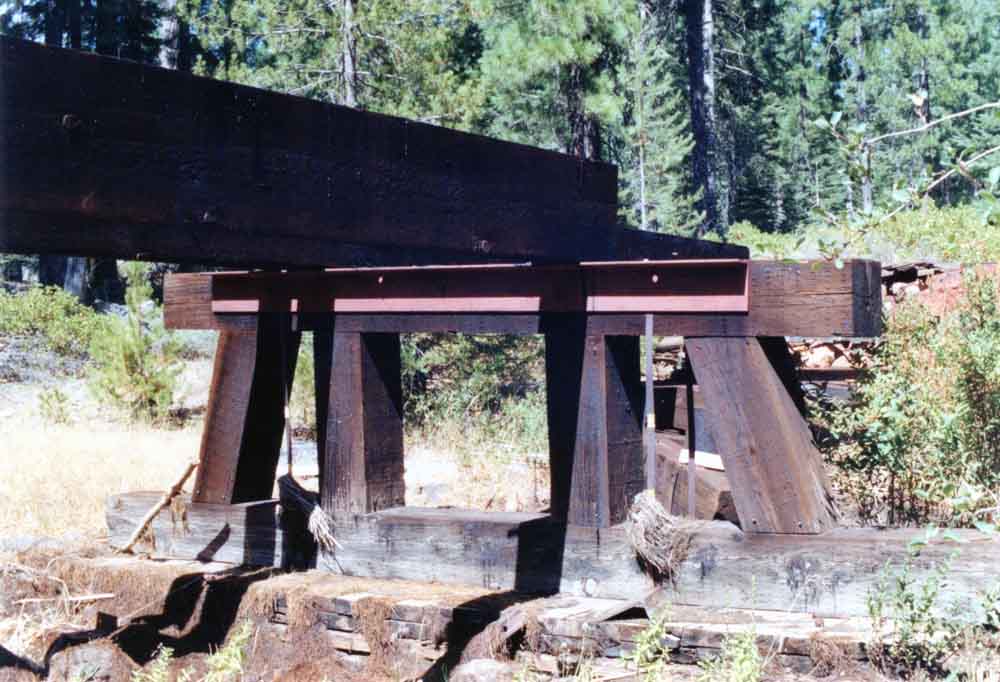 |
|
|
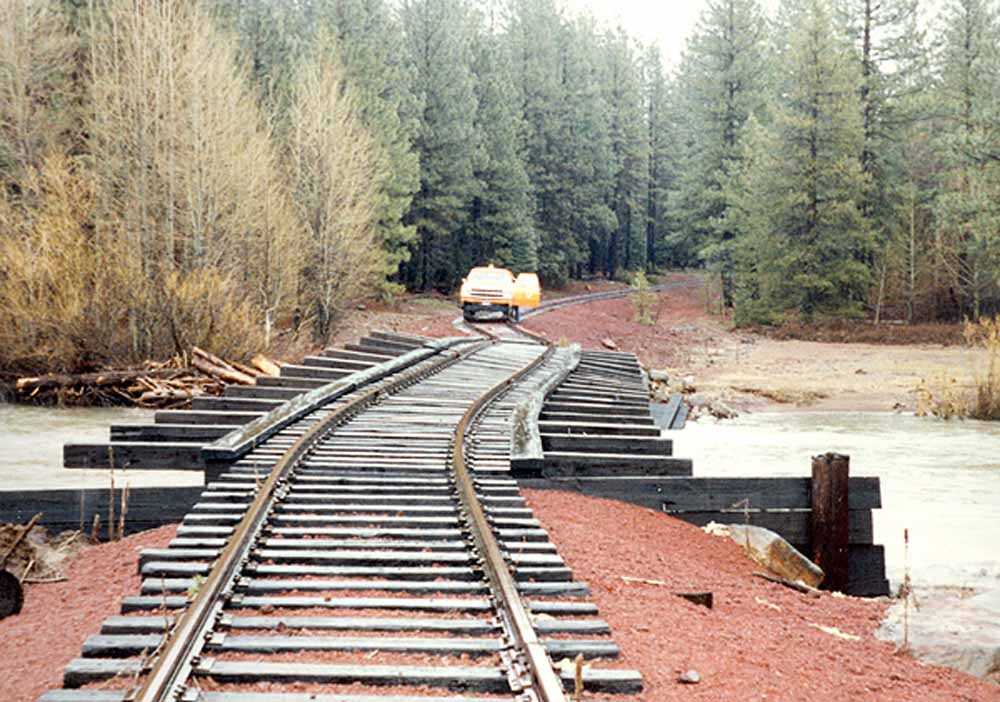 |
|
The Bear Creek bridge washout in 1986 that severed the branch and cut Pondosa off from any further rail service. Travis Berryman collection.
|
|
|
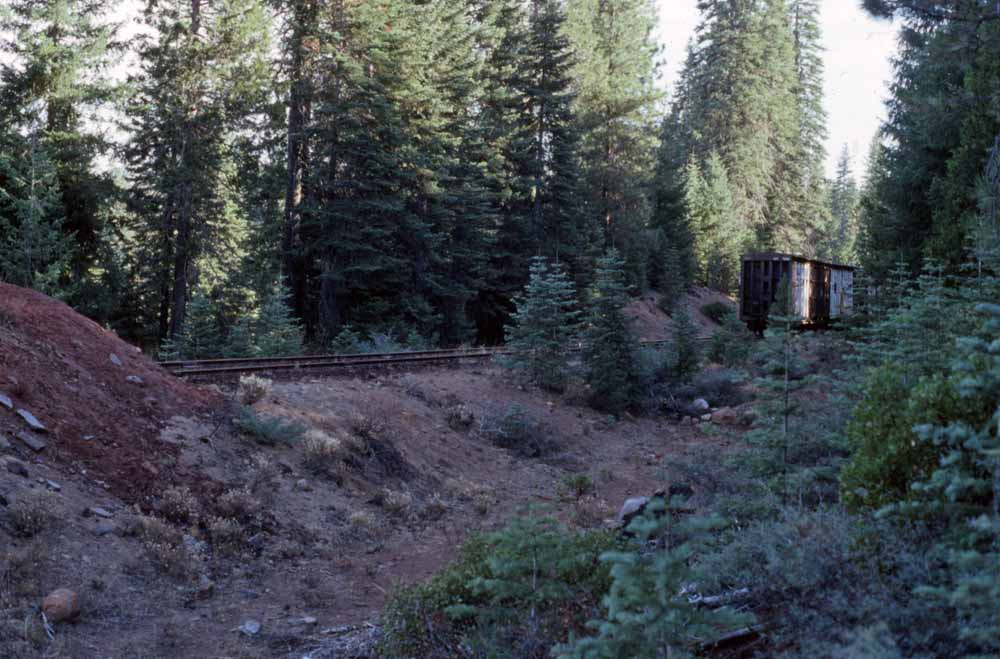 |
|
The end of the truncated Pondosa branch. Lee F. Hower photo.
|
|
|